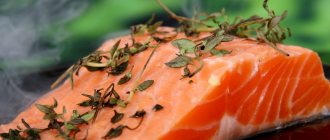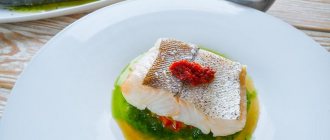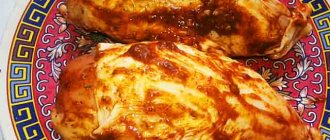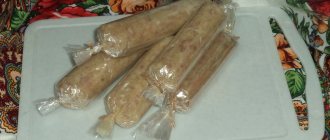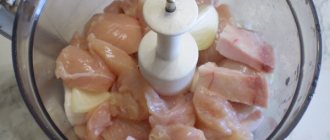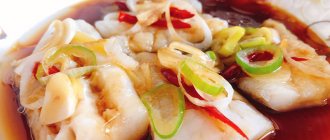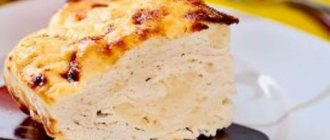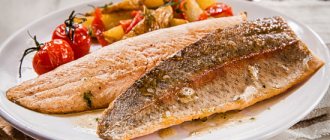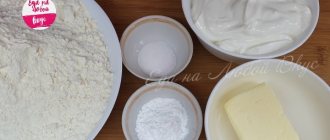What are the benefits of fish?
There are no carbohydrates in fish, but the protein necessary for building muscle tissue is present in sufficient quantities. And it is easier to digest than protein obtained from meat products. Fish is also rich in unsaturated fatty acids, such as omega-3 and omega-6. These fats are absolutely safe for your figure, and even, on the contrary, they trigger metabolic processes in the body, increase immunity, prevent the first signs of aging and prevent the formation of cancer cells.
In order to get the maximum benefit from fish, you should determine the type of preparation that retains all the beneficial elements and vitamins to a greater extent. The calorie content of fish depends on its type and method of preparation. The safest methods for the figure are those in which slaves are cooked in their own fat. Obviously, the calorie content of boiled fish can be several times lower than fried fish.
How to store baked fish
After complete cooling, food prepared from such a product should be placed in a container, sent to the refrigerator, and stored for no longer than 12 hours. The best place for safe placement is the freezer. The same rules should also be applied in the case when part of the food remains uneaten.
Characteristic signs of a spoiled dish are changes in its consistency, smell and color. When such changes occur, food must be disposed of.
Any fish, originally decorated and baked in foil in the oven, turns out especially bright and suitable for the holiday table. This dish is worthy of turning your kitchen into a mini-restaurant for family or invited guests one weekend.
Article design: Ilchenko Oksana
Sea or river?
Sea fish is the most nutritious, and its calorie content ranges from 100 to 350 calories per hundred grams, depending on the type of fish. Such fish include trout, mackerel, and salmon. The leanest are flounder, pollock, hake and cod. It is these varieties that nutritionists recommend for those losing weight. Preference should be given to marine fish, as it contains a sufficient amount of fatty acids that are necessary for the full functioning of the body. If you eat fish on a regular basis several times a week, your well-being, mood and tone of the whole body will significantly improve. Useful elements have a beneficial effect on the health of blood vessels, nails and hair.
Chum salmon in cream sauce
When you add any type of sauce to fish, its calorie content instantly increases. At the same time, taste improves. Chum salmon in creamy sauce is a decoration for the New Year's table.
Ingredients:
- chum salmon fillet (or any other fish of the salmon family) - 1 kg;
- mustard - 1 tsp;
- cream - 700 ml;
- juice and zest of 1 lemon;
- greens - 1 bunch;
- egg yolks - 2 pcs.;
- salt and black pepper - to taste.
Step by step recipe:
- Wash the chum salmon, cut it into steaks, add salt and pepper, and add lemon juice. Marinate for 15-20 minutes.
- Finely chop the greens. Carefully remove the zest from the lemon so as not to touch the white layer - otherwise the sauce will be bitter.
- Mix cream, yolks, mustard, herbs and zest.
- Wrap each steak in foil and add a few spoons of sauce to it.
- Bake in an oven preheated to 180 degrees for 25 minutes. Five minutes before it’s ready, turn on the convection mode and let the fish brown a little.
Calorie content of baked salmon with cream per 100 g is 320 kcal.
How many calories are in boiled, stewed, baked fish?
The healthiest fish is the one that is boiled, steamed, stewed, or baked. It is these cooking methods that allow you to preserve the maximum amount of useful elements and vitamins and preserve all the important properties of fish. The situation changes dramatically if you eat smoked or fried fish. There are practically no benefits in such products, and the calorie content is several times higher.
After cooking, the calorie content of products increases by at least 20%, even with dietary cooking methods.
Let's take pink salmon, for example, whose calorie content is 140 calories per 100 grams. After boiling, baking, stewing, or cooking in the oven, the calorie content of the fish increases to 170-190 calories, depending on what cooking method was used and what accompanying seasonings were added. And after frying, the calorie content of pink salmon can reach 250 calories per 100 grams. In any case, even fried rib is lower in calorie content than the leanest meat.
Red fish, such as raw salmon, has a nutritional value of 143 calories, while baked fish has only 163 calories.
If steamed fish no longer evokes any desire to eat it, you can start baking the fish using foil and avoiding the oil. Foil will help preserve all the beneficial properties, and the absence of oil will eliminate unnecessary calories.
Selection and storage of fish is a primary step that will allow you to get the maximum benefit from the product. When choosing fish, pay attention to the smell and hardness of the product. It is better to cook fish immediately after purchase, while it is fresh, because it is stored for much less time than meat. If you want to save the fish for later, it is best to freeze it, and not just store it in the refrigerator. At a minimum, it will lose all its beneficial properties, and at maximum, it will deteriorate.
How to choose ingredients for oven-baked fish
People learned to cook dishes from the inhabitants of the seas and oceans in the oven from the moment they had fire at their disposal. Today, the technology for creating such food has changed significantly - grills and ovens have come to the rescue, and fires have become an exotic country holiday. However, the main component - fish - is invariably present in various recipes of world cuisine.
Choosing a suitable product for baking is a task that is both simple and complex, because the successful result of the culinary action depends on this. Not every fish is suitable for cooking in the oven. This does not mean at all that some inhabitants of rivers, seas and oceans should be categorically excluded from the “tasty” list.
You just need to keep in mind that not all types of fish can turn out expressive, aromatic and attractive when baked:
| Freshwater species | Product Features |
| Carp | Large individuals with high fat content. Suitable for any heat treatment method |
| Som | The scaleless specimen has almost no bones, which makes recipes easy to follow. |
| Pike | The popularity of fish is associated with the characteristics of its white meat |
| Carp | A “bony” but extremely tasty representative of the fauna with especially tender meat |
| Trout | Suitable for any cooking method |
| Sterlet | It occupies a leading position among freshwater species. Unpretentious in processing and not requiring additional components, this fish, when used skillfully, can turn into a delicious holiday dish. |
| Marine species | |
| Tuna, halibut, eel, mullet, horse mackerel, saury, mackerel, flounder, pike perch, chum salmon | The most popular species of underwater inhabitants in cooking, most suitable for cooking in the oven |
Sea or river creatures such as blue whiting, cod or catfish are not recommended for baking. The reason for this is the somewhat watery and loose meat, which quickly falls apart during cooking, turning into an unsightly and unappetizing mass. Such individuals are suitable for fish soup or frying in a pan.
Having decided on the best types of fish, you should pay attention to several factors that indicate the quality of the product:
- The first characteristic of fish freshness is its smell. It should be slightly marine, tender and pleasant with the aroma of seaweed. “swampy” impurities with pronounced notes of ammonia are present in a spoiled, stale product.
- Next you need to “look” into the eyes of the fish. Unclouded and clean is a sure sign of its freshness, especially if the scales of an individual shine, as if shimmering from the sun.
- An important evidence of the quality of the product will be the thinnest layer of glaze - an ice crust covering the fish in packaging or in ice.
- A dull and gray-looking carcass can only mean one thing - the product has been frozen several times. Even if the fish was once fresh, fatty and juicy, these qualities can no longer be “reanimated” - the cooked fish will become dry and tasteless.
Fish baked in foil in the oven is in demand by many fans of healthy eating, but they often avoid including it in their menu because of its specific smell. This natural “deficiency” can be corrected with the help of mixtures of herbs.
The most popular seasonings used in recipes are the following plants:
- thyme, turmeric or coriander - have a bright and rich aroma;
- oregano, anise or marjoram - natural enhancers of the taste of fish food;
- mint, laurel leaves, or lemon balm - will complement the fishy smell of food well and slightly sweeten the product;
- parsley, onion or celery - will relieve the fish of the “swampy” smell. For the same purposes, lemon juice is used, which perfectly neutralizes the unwanted “aroma” in the dish.
You should avoid consuming cinnamon, nutmeg, cumin or paprika - such spices can spoil its exquisite flavor bouquet created by nature itself.
How many calories are in fried fish?
If you did choose a cooking method such as frying, then it is better to do it without oil, or with minimal addition of it. In order to choose the right cooking method, you should rely on the type of fish. For example, it is customary to bake or fry fatty fish in its own juice. It does not require adding oil and even frying will not add extra calories; the main thing is to take care of the non-stick frying pan in advance so that it does not lose its juiciness. Lean fish should be boiled or steamed, and in exceptional cases, fried with oil. The calorie content of fried fish in oil, for example, flounder, is 223 calories per 100 grams.
For those who count calories and watch their figure, fried fish in oil is prohibited.
Calorie content of a gourmet delicacy
Red fish fillet of any kind is a real delicacy, which is distinguished by a refined, refined taste, as well as a rich mineral and vitamin reserve. This fish is quite fatty, which is why its calorie content is high. A hundred-gram serving of fish contains one hundred and fifty-two kilocalories. However, due to the large amount of easily digestible proteins and valuable fat in fish fillets (there are no carbohydrate compounds in it), it is considered an ideal component of diets.
On a note! Of course, we don’t eat red fish raw. But gourmets simply love raw salmon fillets. In order not to harm yourself, you need to choose freshly caught fish for this purpose, and one that lived in salty water - the sea, the ocean. It is salt that prevents parasitic microorganisms from developing in the fish.
Many people love salted fish. How many calories are in salted red fish? This figure ranges from two hundred to two hundred and ten kilocalories per hundred grams. Lightly salted fish has lower calorie content.
On a note! If you decide to salt the fish yourself, buy a whole carcass rather than steaks, then the treat will have a more delicate taste. And one more secret: the larger the carcass, the juicier it will turn out during the salting process.
Marinated fish brings us two hundred and thirty-seven kilocalories. This indicator is influenced by the components of the marinade mixture.
What method of heat treatment should we choose so that fish fillets do not bring us extra pounds? All experts will answer you unanimously - boil it! Regardless of whether you cook the fish in the classic way - in a pan or steamed, its calorie content will be one hundred and forty-nine kilocalories. In addition, all the “usefulness” will be preserved in the fillet.
Fish cooked in the oven is delicious. How many calories are in baked red fish? It depends on the chosen recipe. If you bake fish in foil without adding additional components, its calorie content will be two hundred and one units. Such a high indicator is obtained due to the fact that the carcass will languish in its fat and juice.
You can reduce the calorie content of fish by adding assorted vegetables and mushrooms to it. The energy value of such a treat per hundred grams will contain one hundred and fifty-four kilocalories. And when baking fish fillets under a vegetable “coat” of carrots and onions, the calorie content of the treat will be one hundred and forty-two kilocalories.
Now let's find out how many calories are in fried red fish. Here again, you need to take into account all the components of the dish. If you fry fish in flour breading, its energy value will be one hundred and forty-six kilocalories. And fillet fried in egg-flour batter will give us an average of two hundred and ten kilocalories.
Red fish is also grilled in oil. How many calories are in red fish in oil? A one hundred gram portion of such fish will contain two hundred and eighty kilocalories.
And of course, we can’t help but remember the red fish fillet sandwiches. How many calories are in a red fish sandwich also depends on its ingredients. So, a classic appetizer with cream cheese and fish fillet (salted or smoked) brings us two hundred and forty kilocalories. But if instead of cheese you use butter as the basis of the sandwich, its calorie content will increase significantly.
How long does it take to cook fish?
Don't forget that the fish cooks quite quickly. It only takes 10 minutes to boil mackerel. Therefore, you should carefully monitor the dish during the cooking process so as not to overcook or overcook it. Fish goes well with herbs and spices such as dill, parsley, basil, thyme, and paprika. The most dietary fish is trout; the calorie content of fish per 100 grams is only 90 calories. You can eat such fish at least every day, but with fattier varieties you should be careful and not overuse it. Helpers in the fight for a good figure will be such varieties of fish as hake, perch, pollock, and navaga. Their calorie content also does not exceed 100 kcal. You can prepare a completely variety of dishes from fish - cutlets, casseroles and even fish soufflé.
Secrets of cooking oven-baked fish
There are no uniform rules for creating such dishes in the oven. Each type of underwater inhabitants requires individual handling. However, the principles and culinary tricks of correct and tasty baking of fish in the oven using foil, developed over the years, are still available.
For example:
- A prerequisite for obtaining quality food from this component is pre-processing. Fish should not be defrosted 2–3 hours before placing it in the oven, but not less than 24 hours in advance, by transferring the packaging from the chamber to the refrigerator.
- The same process includes freeing the carcass from scales, if any. Then you need to remove the gills and entrails, cut off the tail and fins with scissors, rinse the specimen thoroughly, and blot it with paper napkins.
- It is not recommended to separate the head of fish that is to be baked. Such manipulation will lead to loss of juice.
- When wrapping the carcass in foil, you need to leave a lot of empty space on top so that the meat is thoroughly cooked. The ends of the paper should be sealed as tightly as possible, which will preserve the formed juice inside the package.
- Additional ingredients included in the baking recipe can not only be placed directly on the fish, but also placed inside.
- If the carcass turns out to be a bit dry, you can coat it with a small amount of fresh butter or scatter pieces of it under foil.
- Along with baked fish, a variety of side dishes are usually prepared. To save time and at the same time enrich the product with additional flavors and aromas, it is enough to stuff the carcass with the selected ingredients. Vegetables, fried mushrooms, cereals (rice or buckwheat), and boiled eggs are used as filling.
- Very often, tomatoes, potatoes, herbs and spices follow along with the carcass, which also become a nutritious and satisfying addition to the main product.
- Baking time on average ranges from 20 to 40 minutes, which depends on the size of the individual, the components placed with it, and the power of the oven.
- It must be borne in mind that the higher the level of food placed in the oven, the hotter it is. The choice of location for the future dish also depends on whether the food is prepared on a baking sheet or on a wire rack. Ideally, it is advisable to change levels during the cooking process, moving food to the upper or lower tier. This will ensure uniform heating of all components of the dish.
Fish, deliciously baked in foil, should not be in the oven for very long. However, this period should be enough to completely destroy the microorganisms that have settled in the carcass. You can check the readiness of food using a fork, easily separating the fillet from the ridge.
To obtain an appetizing appearance of baked fish, at the end of the process, open the foil, increase the heating temperature, and wait for the formation of a golden brown crust. An excellent way to serve the dish is to place it in separate “plates” made of aluminum paper.
Small parts of the fish along with the rest of the components should be placed on foil, the edges of the canvas should be fastened in the form of a circle, square or “boat”, and the workpiece should be sent to the oven. Hot portions, placed on elegant serving dishes, look very original and are convenient for every guest to consume.
Thin slices of lemon are popular decoration elements that not only create an interesting appearance for the dish, but also improve the taste of the food.
It is necessary to make several shallow transverse cuts into which to insert the halves of the citrus fruit rings. In another option, you can make a cut along the ridge on the carcass and place small tubers of young potatoes mixed with cherry tomatoes into the resulting cavity.
You can use a variety of techniques for effectively serving a fish dish, with fresh herbs becoming the main and win-win element of the decor. Just one sprig of curly parsley is enough to instantly transform a mouth-watering dish.
The beneficial properties of some fats in high-calorie fish
However, the benefits are not limited to low-calorie fish. For example, everyone’s favorite red fish, despite its high calorie content, is rich in omega-3 polyunsaturated fatty acids, which are very beneficial for the body. Fats reduce cholesterol levels, perform a protective function, strengthen blood vessels, minimize the risk of heart attacks and strokes, prevent the production of cancer cells and even rejuvenate. It is recommended to eat red fish during difficult work or exams, as its properties have a positive effect on brain activity. The calorie content of red fish is approximately 200 calories per 100 grams.
To maintain health, it is recommended to consume 100-120 grams of fatty fish several times a week. The main thing is to forget about smoked and dried fish, as it causes not only harm to your figure, but also to your health. The benefits of fish are preserved only with proper preparation. Almost all seafood has the same valuable properties, which are also an excellent source of iodine, calcium and iron. The calorie content of fish is so low that it can be included in the list of dietary products.
Oven baked fish recipes
It is very important to have a fish day at least once a week. You can prepare a delicious dish in different ways, among which the method of baking in foil is especially popular. It is best to master all the intricacies of obtaining food that is healthy for the body through practice, using a selection of step-by-step recipes.
A universal way to bake fish
Fish baked in foil in the oven is decorated according to personal tastes and preferences. The presented method of preparing a dish in aluminum paper is basic, suitable for almost any type of river or sea life.
List of components:
- sunflower/olive oil - 2 tbsp. l.;
- bulbs - 2 pcs.;
- fish - 2 carcasses;
- white pepper, thyme, tarragon, basil - 2 whispers each;
- salt - up to 15 g;
- lemon fruit;
- dill, rosemary.
Cooking order:
- Peel the fish and remove the gills if using whole fish. Gut the carcasses, remove dark films.
- Rinse the products thoroughly and dry with napkins.
- Lubricate the inside of the specimens with salt and other spices, and treat the outside exclusively with seasonings.
- Cut the peeled onion into half rings and arrange the lemon into circles.
- Grease the foil and place the fish. Place onion, citrus fruit slices, a sprig of rosemary and dill in the bellies. Cover the carcasses with herbs and slices of citrus fruit on top.
- Wrap the foil tightly and leave for 30 minutes. into an oven preheated to 200 °C.
Any vegetable side dish is suitable for this dish.
Baked tilapia
Due to its very high protein content, the fish was nicknamed “chicken of the sea.”
Ingredients:
- olive oil - 50 g;
- carrots - 200 g;
- onion - 150 g;
- soy sauce - 30 g;
- sausage cheese - 200 g;
- fish fillet - 600 g;
- granulated sugar - 15 g;
- salt - to taste.
Cooking method:
- Rinse the tilapia layers thoroughly and dry with paper towels. Spread foil on a baking sheet.
- Sprinkle the fillets with salt and sugar and brush with olive oil.
- Peel the onion and cut into rings. Coarsely grate the carrots.
- Place half of the vegetables on metal paper treated with fat.
- Place layers of fish and the rest of the slices on top. Sprinkle the food with soy sauce and sprinkle with shavings of cheese.
- Connect the edges of the package, secure tightly, and send the workpiece for 20 minutes. into an oven heated to 220 °C.
At the end of the process, open the foil, brown the top layer, and then serve the dish.
Mackerel in foil
Tender fish meat with a spicy taste is distinguished by a small number of bones and a rather strong smell of fat, which celery and parsley will help neutralize.
Grocery list:
- sunflower oil;
- onions - 2 pcs.;
- potatoes - 8 pcs.;
- fish carcasses - 4 pcs.;
- celery root - 20 g;
- lemon juice - 6 tbsp. l.;
- spices (salt, pepper), parsley.
Preparation procedure:
- Spread foil on a baking sheet and coat with oil. Turn on the oven and set the temperature to 180 °C.
- Clean each carcass, rinse and dry with paper towels. To thoroughly soak the meat, make small cuts on the surface and sprinkle the fish with lemon juice.
- Remove the skins from the potatoes and cut into slices. Remove the skins from the onion and arrange the vegetable into rings. Grate the celery root, chop the parsley sprigs, and mix the mixture.
- Place half of the prepared potato mixture on the foil. Place the mackerel on top, cover the carcasses with the rest of the cut.
- Connect the edges of the foil, send the workpiece to an already heated oven for 1 hour.
Fish baked in foil in the oven.
A simple recipe. Unfold the paper in 5–10 minutes. until the end of the baking process. Serve the dish to the table after an appetizing crust has formed.
Trout baked with pesto sauce
Fish baked in foil in the oven goes well with Italian gravy. A representative of the salmon family is especially good in combination with aromatic sauce.
Product set:
- olive oil - 4 tbsp. l.;
- avocado - 2 pcs.;
- brown rice - 400 g;
- trout - 900 g;
- onion, cucumber - 1 pc.;
- arugula - 200 g;
- drinking water - 100 ml;
- sea salt, pepper - to taste;
- peas - 300 g;
- dill, cilantro - 4 tbsp. l.
For Pesto:
- garlic cloves - 2 pcs.;
- Parmesan cheese - 200 g;
- pine nuts - 5 tbsp. l.;
- basil - 400 g.
Step-by-step preparation:
- All components of the future dish should be thoroughly washed and dried well. Heat the oven to 200 °C.
- To create the Italian sauce, place 4 tbsp in a blender bowl. l. nuts (the rest will be used for decoration), garlic, basil. Mix the mixture until a homogeneous structure is obtained. Transfer 6 tbsp. l. fragrant mixture into a separate bowl.
- Add olive oil to the unit’s container and turn on the device again. After a thick consistency has formed, add Parmesan and mix the mass thoroughly again.
- Divide the pre-processed trout into pieces and place them on greased aluminum foil. Sprinkle the fish with sea salt and pepper and top with Pesto.
- Wrap the paper tightly and leave for 15 minutes. into the oven.
- At this time, pour rice into a heated frying pan, add finely chopped onion, and set aside a portion of the sauce. Cook the food for 3 minutes, then add peas, cilantro, dill and arugula. Simmer the contents of the container until all ingredients are ready.
To properly prepare the dish, place a portion of the side dish on a serving plate and place a piece of baked trout on it. Decorate the composition with avocado slices and cucumber rings, scatter pine nuts on top.
Halibut baked with vegetables and mushrooms
Required components:
- cherry tomatoes - 15 pcs.;
- sweet pepper - 2 pcs.;
- halibut - 3 steaks;
- champignons - 15 pcs.;
- lemon;
- pepper (preferably coarsely ground), salt - according to preference.
Cooking technology:
- Salt and pepper the fish pieces and place them on separate sheets of foil.
- Cut the mushrooms into thin slices, divide the tomatoes into halves, remove the seeds from the bell pepper and arrange into strips.
- Place the processed products one by one on the halibut steaks, add lemon slices.
- Fix the edges of the paper, send the workpiece for 25 minutes. into the oven (180 °C).
Serve the dish hot.
Classification of fish used for food
Dishes prepared from fish occupy a significant place in the national Russian and Belarusian cuisines. All existing types of fish can be divided into 3 large groups:
- fish having white meat;
- fish having red meat;
- fish with meat with a high degree of fat content.
Important! Fish with white meat is considered the most edible and has excellent taste, and fish with red meat is the most nutritious product.
In addition to this classification, fish are divided into several groups depending on their habitat:
- freshwater fish;
- migratory fish;
- brackish water fish;
- marine;
- oceanic.
Fish with white meat
Freshwater fish species live in fresh water throughout their entire life. Reproduction of such fish also occurs in fresh water. This type of fish includes carp, bream, pike, catfish, sterlet, etc.
The group of migratory fish includes salmon and sturgeon. These fish species live in sea water and breed in fresh water. Sea and ocean fish constantly live in the salty water of the seas or oceans. Reproduction of fish belonging to these 2 groups is also carried out in sea and ocean water. These 2 groups of fish include tuna, anchovy, cod, flounder, etc.
Pink salmon fish cutlets
Ingredients:
- – pink salmon – 600 gr.,
- – onion – 1 pc.,
- – chicken eggs – 1 pc.,
- – milk – 40 ml.,
- – fresh dill – 5-6 sprigs,
- – salt – a pinch,
- – pepper – a pinch,
- – vegetable oil – 1 tbsp.,
- – corn flour (for breading) – 3 tbsp.
How to cook at home
- The first step is to prepare all the ingredients. Take pink salmon, first remove it from the freezer, you can leave the fish overnight on the bottom shelf of the refrigerator so that the fish slowly thaws. Afterwards, you need to cut the fish in half, remove the backbone and remove the skin. Check the pink salmon fillet to ensure there are no bones. Pass the pink salmon fillet through a meat grinder, using the finest grate. Transfer minced pink salmon to a bowl.
- In a separate bowl, whisk a small egg and milk.
- Pour the milk-egg mixture into the minced fish. Also finely chop the peeled onions and add the onions to the bowl.
- Rinse a couple of sprigs of fresh dill, chop the dill finely and add to the rest of the ingredients. Add a pinch of salt and pepper to the bowl with the minced fish.
- Mix the minced meat thoroughly. Then form the minced meat into small cutlets. If desired, the cutlets can be breaded in corn flour or breadcrumbs.
- The cutlets need to be quickly fried in a dry frying pan, which can also be greased with a drop of oil. Then cook the dietary fish cutlets until cooked in the oven at 180 degrees for 8-10 minutes.
- Bon appetit!
Mackerel in tomato sauce
Required Products:
- – 400 grams of mackerel,
- – 100 grams of onion,
- – 100 grams of carrots,
- – 1 bay leaf,
- – 2 tbsp. l. tomato paste,
- – 150 grams of water,
- – 1.5 tables. l. vegetable oil,
- - salt pepper.
How to cook at home
- Lightly saute the grated carrots and finely chopped onions in a frying pan, adding a little vegetable oil. When the vegetables become soft and transparent, add tomato paste and a little water to create a not very thick tomato sauce. Simmer carrots and onions in tomato sauce for 10 minutes.
- We wash the mackerel (it should already be defrosted), clean it from the fins, head, entrails and intestines. Cut the mackerel into medium-thick pieces.
- Add the fish pieces immediately to the simmering tomato sauce. This way we don’t fry the fish and it doesn’t absorb a lot of oil. We do not use additional vegetable oil. In tomato sauce, the fish will be more dietary and will be cooked as if steamed.
- Simmer the mackerel until cooked, about 10-15 minutes, making sure to cover with a lid. The mackerel will be perfectly simmered, cooked and will turn out tasty and tender. It will be soaked in tomato sauce and will be very aromatic. At the end of cooking, the mackerel pieces can be turned over and simmered for another 5 minutes.
- Mackerel in tomato sauce is good both hot and cold. Serve it to the table along with the sauce. Bon Appetite!
How is fish useful?
In addition to the fact that it is an easily digestible product (digested in just two hours), fish contains vitamins, in particular A and D, calcium, iodine, phosphorus, fluorine, and zinc. It saturates the body with amino acids and serves as a source of natural protein.
Photo: istockphoto.com
Fish fats are also very healthy: they support the heart, blood vessels, immunity, brain, reproductive system, and gastrointestinal tract. Improves the quality of nails, hair and skin condition. Fatty acids also cleanse the body of bad cholesterol, restore metabolism, and stimulate the proper functioning of the nervous system and brain.
Remember everything: 5 foods that improve memory
Pollock in sour cream in a frying pan
Products:
- – fresh frozen pollock – 1 pc.,
- – water – 100 ml.,
- – onions – 1 pc.,
- – sour cream 10% – 100 gr.,
- – bay leaf – 1 pc.,
- – sunflower oil – 1 tbsp.,
- – fresh carrots – 1 pc.,
- – salt – 0.75 tsp.
Important information:
It takes approximately 40 minutes to prepare the dish. Under no circumstances should you defrost pollock in a container of water or in a microwave oven, because the fish will be like rubber. The fish carcass should be defrosted slowly in the refrigerator, and then cooked.
How to cook at home
- 1. First, peel the onion and cut it into thin rings. Place in a heated frying pan with vegetable oil. We will fry the vegetable until light golden brown.
- 2. Peel the carrots and rinse under water. After this, grate using a large-tooth grater. Place on the fried onion rings and fry the carrots until golden brown.
- 3. Place chopped pieces of pollock on top of the vegetables and add salt.
- Tip: It is necessary to first wash the fish carcass, remove the entrails, remove the black shell from the inside, and clean off the scales. After this, dry the pollock on a paper napkin. Then cut into portions.
- Tip: To ensure that the fish is tender and the pieces fall apart, you need to add water and simmer a little.
- 4. Coat the top part of the pollock with sour cream and add a bay leaf. Close the pan tightly with a lid and simmer for 20 minutes over low heat.
- Tip: The main rule is not to dry out the fish delicacy during long cooking. Because it will become rubbery and dry.
- 5. After this, mix the resulting fish-vegetable mixture.
- Tip: For those who like spicy pepper dishes, it is recommended to add a mixture of peppers.
- 6. Stewed pollock with vegetables is ready to eat. Serve hot in combination with mashed potatoes, boiled rice, and pasta.
- Bon appetit everyone!
Baked mackerel with onion and lemon
Required Products:
- – 400 grams of frozen mackerel,
- – 150 grams of onions,
- – ¼ lemon,
- – 2 tables. l. olive oil,
- – salt and pepper to taste.
How to cook at home
- Defrost the fish in advance, cut off the head, remove all the insides and rinse with water, then wipe the mackerel with napkins to remove drops of water. It is good to clean the belly of the mackerel from black films. Place quartered onion into rings on the bottom of the pan; it will serve as a cushion for the fish. Place mackerel on top, lightly salt it, add ground black pepper.
- Feed the fish with olive oil and sprinkle with lemon juice, which will remove the specific aroma of the fish. You can put a few slices of lemon on top, it will give its juice to the fish during baking, but do not put a lot of lemon so that the mackerel does not turn out sour.
- Bake mackerel with onion and lemon for 35-40 minutes, the fish becomes soft, juicy and very aromatic. An average temperature of 180 degrees is suitable for baking. Also, after baking, a beautiful golden brown crust forms on the mackerel.
- We serve the finished fish to the table both hot and cold; it will be very tasty under any circumstances. Bon Appetite!

